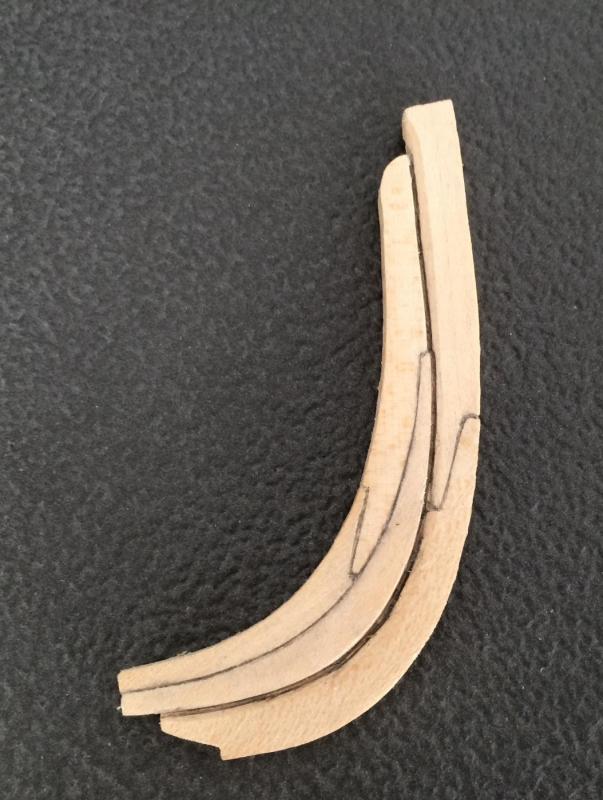-
Posts
97 -
Joined
-
Last visited
Content Type
Profiles
Forums
Gallery
Events
Everything posted by Mike40
-

Drill Bit Sizes Appropriate for Ship Modeling?
Mike40 replied to Mike40's topic in Modeling tools and Workshop Equipment
Thanks David. I am in fact planning to buy a pin drill, but I'm not sure it will be best for holes that have to be at a precise angle, but probably great otherwise. -

Drill Bit Sizes Appropriate for Ship Modeling?
Mike40 replied to Mike40's topic in Modeling tools and Workshop Equipment
Thanks much for the help guys, this will give me info enough to proceed. I bought a chuck for my Dremel some years ago. It tightens by hand to any size so I don't use the collets anymore. Still not sure how it will work on the smaller bits, but I still have the different sized collets in case and I suppose I can get even smaller ones if needed. I am planning to attach a bracket to my drill press that can hold my Dremel to avoid hand holding it and breaking bits. Not sure how well it will work until I try it out. I'm not too keen on buying a micro drill press until I find that I can't live without one. In fact I am hoping to get by without any micro machines at all if I can help it. My shop is already overcrowded enough! -
I would appreciate any tips on drill bit sizes for ship modeling. My first model will be a 1:48 scale. I have seen mentions of drill bit sizes given as numbers like #1, #3, etc. here on the forum, but here in Norway we use the metric scale and not the number system. If anyone can tell me the sizes I need in inches I can convert that to metric, or if you can tell me in millimeters even better. I don't have a pin drill yet so I will probably be using the bits in my Dremel. I can't get the thick shaft small bits here so I am hoping my Dremel will be able to grip the small diameter bits well enough. I can order small bits from out the country, but it's easier if I can buy them here and they are a lot cheaper.
-
Looking forward to following your log Rob. The Endeavor book should be a great read and make your modeling experience all the more satisfying.
-
Excellent result on this build Mike. Your build log, along with others was very interesting and a lot of good ideas were gleaned for my own Washington build. So far I've been busy preparing the wood for the project. The re-sawing and planing is finished. The sanding was supposed to be done yesterday, but after all the donkey work I had to have some fun so instead I did a practice assembly of the bow pieces. I tried to simulate caulking by just penciling over the glue joints without much success. Next time I will not make the mistake of fake caulking the rabbet.This assembly will be made over again and also include the slots for the cant frames which I forgot to do this time. The cutting of the rabbet also has to be improved a little.
- 175 replies
-
- washington
- galley
-
(and 1 more)
Tagged with:
-
Hi Ben, I'm new to the forum and just read your entire log to date. Excellent craftsmanship and results. It's really a shame about the major problem you encountered with the humidity after your move, but I'm sure with the determination you have displayed thus far you will overcome it. On a more positive note, your problem is a valuable learning point for myself and perhaps other new modelers. Luckily (or unluckily) it rains a lot all year here in Norway, so I have seldom had any significant humidity problems with my normal woodworking, but considering the very thin wood used for modeling it is certainly a potential problem to avoid, so I thank you for sharing your misfortune with us. Looking forward to a continuation of your wonderful build!
- 889 replies
-

HMS Naiad 1797 by albert - FINISHED - 1/48
Mike40 replied to albert's topic in - Build logs for subjects built 1751 - 1800
Your craftsmanship on this beautiful ship is beyondt amazing Albert. -
Super result to date Mike. I have read all of your posts on this log and I have not only learned much from yourself and the comments of others here, but I also greatly enjoyed seeing a such a fine model emerge. I do not think that your work so far would have come out so well if you had not from the very start been seeking excellence and been willing to redo those things you were not satisfied with. Looking forward to the rest of the build!
- 967 replies
-
- hahn
- oliver cromwell
-
(and 1 more)
Tagged with:
-
Thanks for your encouraging words Mick. I started milling my stock today which will take me a few days. I hope to get started on the build sometime next week.I decided to use mainly Basswood and I have some other contrasting species like walnut and African blackwood for trim, etc. I'll start a log as soon as I have some progress to show. I don't think this will be an easy build for me, but I am sure looking forward to it.
- 504 replies
-
- washington
- galley
-
(and 1 more)
Tagged with:
-
I can't tell you how impressed I am with the quality/precision of your work on this build Mick. I received my Washington Galley plans in the post yesterday and found your log shortly afterward. I plan to mill my wood next week and then get started. I can't hope to equal the quality of your build as my tools are mostly macro sized and my modeling skill set is definitely well south of yours, but your build log will certainly give me a whole lot of inspiration and useful info at the same time. A daunting project for my first ship model, but if mistakes are any measure of learning, then I will probably be learning a lot!
- 504 replies
-
- washington
- galley
-
(and 1 more)
Tagged with:
-
Good progress and nice work Adam. I will following your log with great interest. I just received my Washington plans in the post today. They are wonderfully done. I haven't yet decided on a wood species, but I am leaning towards maple or basswood as I have both in my shop and also some walnut and other sorts that might be useful for trim here and there. I also have some small chunks of pear in case I can find some use for them. This will be my first ship model so I'm sure I will pick up a lot of helpful tips from your log. Now I just have to mill the wood (not a fun job) and then start building!
-
Very nice photos Jack. I live near Hafrsfjord where Harald Harfagre fought a major battle to secure his dominance over the area where I live. According to the legend, row upon row of viking ships were lashed together and they fought from ship to ship. My daughter-in-law's uncle, Jostein Nylund, was one of the prime instigators of the monument. Here is a couple of photos I took of the sword monument in memory of that battle. The 2nd photo is just to show the scale.
-
Besides admiring in general your precise work on this model Frank I am particularly impressed with what a great job you did on the decking. It greatly enhances the realism and is in keeping with the overall quality of your work.. The question I had about the reason for chocks between the frame futtocks has been answered by an excerpt from J.R. Adams book on maritime archeology, https://books.google.no/books?id=VprwAwAAQBAJ&pg=PA183&lpg=PA183&dq=futtock+chocks&source=bl&ots=RmBHMh9mlf&sig=Je3oD-5ckK8d1eauyJmPKL-HAU0&hl=en&sa=X&redir_esc=y#v=onepage&q=futtock%20chocks&f=false According to the book futtocks were made from naturally curved wood where the long grain was consistent throughout the work piece. Later, these curved pieces were increasingly difficult to obtain and straighter pieces had to be used instead with the consequence that there would be crossgrain towards the ends after cutting to shape. By cutting off the crossgrain on the top ends of futtocks and inserting a chock, strength could be maintained. Further, it was specified that at least 1/3 of the futtock thickness on the bottom at the ends should be preserved.
- 649 replies
-
- dunbrody
- famine ship
-
(and 2 more)
Tagged with:
-
This is a very relevant thread and should be regarded as very good advice to anyone starting out in model ship building, or any other new endeavor for that matter. I do totally agree with Chris about the wisdom of taking on projects commensurate with skill levels, but I am approaching my first build from a different perspective (It's always fun to have at least one dissident in a crowd!). I am planning to build the HMS Ontario as my first model when I should probably build something far simpler to get started. Now I know this probably sounds stupid and perhaps arrogant to those of you who have earned your spurs by completing a series of projects, each with increasing degrees of complexity. My particular reason for choosing a relatively complicated project to begin with is mainly due to my age. I'm not sure how many years I have left and I would like to use them to at least complete on ship that I love. During my 20 years of woodworking I experienced the very same beginner problems that Chris describes, although I did manage to finish all of my projects (except for a couple I destroyed out of frustration). When I first began in woodworking my whole focus was on getting my projects finished as quickly as possible. I was very eager to admire my latest product and to revel in my new found craftsmanship. With increased experience my ambition level rose, but then I found that it took more time to get the kind of results I hoped for. This made me reassess my motives for what I was doing and I began to ask myself whether I was just interested in the finished products or the actual work. This was a game changer for me. It took awhile before it became obvious to me that most projects are actually composed of a series of smaller projects assembled into one. Finally understanding this principle I became blessed with the gift of what many would call 'patience'. The word patience however is a complete misnomer when applied to doing conscientious work as it implies that you are tolerating the work instead of enjoying it. I found that by adhering to the idea of many small projects making a whole that I got much more fulfillment out of the work process and the joy of completing each sub-project successfully, not to mention much better overall results. For those reasons I found the fun level greatly increased and I no longer worried about the time factor, especially since I was retired. I also learned that with this philosophy complex projects became much simpler to execute even though some research and new skills might be required for the different steps. Of course it remains to be seen if my approach will work for me on my first and perhaps only build. It seems to me from reading posts here in the forum that with ship modeling it might sometimes be more difficult to understand what a part should look like than actually making it!. Another big hurtle must be developing a good understanding of the terminology. I'm working on that now and I'm also printing drawings of ship nomenclature from the web and reading all the wonderful build logs and related comments here on the forum to get a good general idea of the build sequence and some insight into how the various parts are made. It will be interesting to see what happens when I begin on my first and perhaps only build about a month from now, but whatever happens it will surely be a lot more satisfying than sitting in an easy chair!
-
Excellent work and a great build Frank. It couldn't have been the easiest crossing for those poor immigrants. I'm late to the party being a newcomer to the site, but I did read your log this evening from start to this point and I found much of interest. It looks finished or nearly finished if I'm not mistaken. Your photos and work descriptions covered the subject very thoroughly. One thing I still can't get my head around is the chocks inserted into the frames as I couldn't see how they helped the mating with their sister frames. Where they used as some kind of spacer between the frames?
- 649 replies
-
- dunbrody
- famine ship
-
(and 2 more)
Tagged with:
-

R/C ...WHAT TYPE OF GLUE SHOULD BE USED???
Mike40 replied to Cap'n Rat Fink's topic in RC Kits & Scratch building
Has anyone used hot hide glue on their models?
About us
Modelshipworld - Advancing Ship Modeling through Research
SSL Secured
Your security is important for us so this Website is SSL-Secured
NRG Mailing Address
Nautical Research Guild
237 South Lincoln Street
Westmont IL, 60559-1917
Model Ship World ® and the MSW logo are Registered Trademarks, and belong to the Nautical Research Guild (United States Patent and Trademark Office: No. 6,929,264 & No. 6,929,274, registered Dec. 20, 2022)
Helpful Links
About the NRG
If you enjoy building ship models that are historically accurate as well as beautiful, then The Nautical Research Guild (NRG) is just right for you.
The Guild is a non-profit educational organization whose mission is to “Advance Ship Modeling Through Research”. We provide support to our members in their efforts to raise the quality of their model ships.
The Nautical Research Guild has published our world-renowned quarterly magazine, The Nautical Research Journal, since 1955. The pages of the Journal are full of articles by accomplished ship modelers who show you how they create those exquisite details on their models, and by maritime historians who show you the correct details to build. The Journal is available in both print and digital editions. Go to the NRG web site (www.thenrg.org) to download a complimentary digital copy of the Journal. The NRG also publishes plan sets, books and compilations of back issues of the Journal and the former Ships in Scale and Model Ship Builder magazines.





